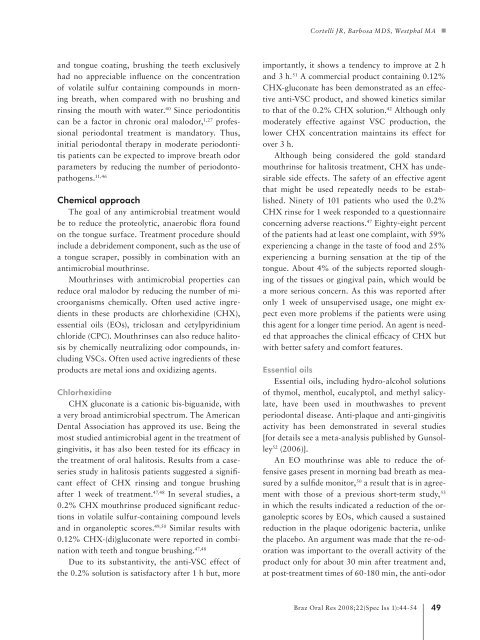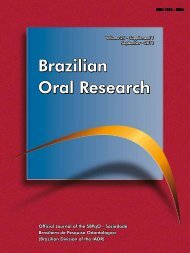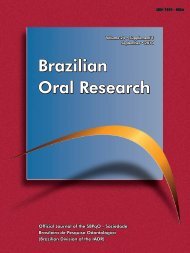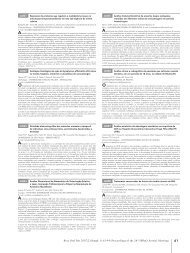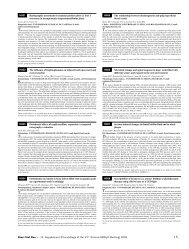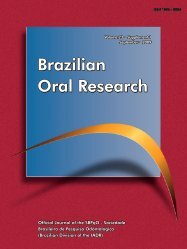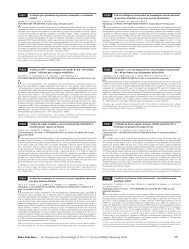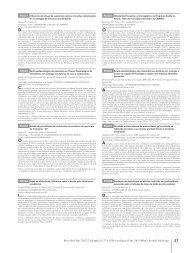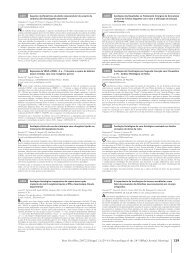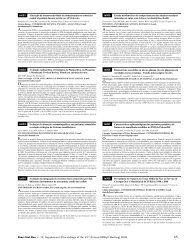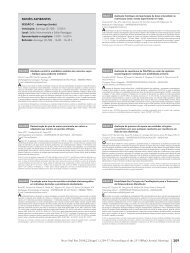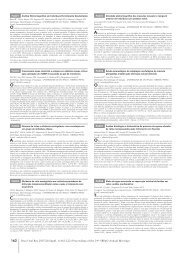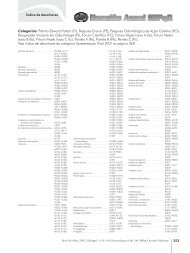Brazilian Oral Research Brazilian Oral Research Brazilian Oral
Brazilian Oral Research Brazilian Oral Research Brazilian Oral
Brazilian Oral Research Brazilian Oral Research Brazilian Oral
Create successful ePaper yourself
Turn your PDF publications into a flip-book with our unique Google optimized e-Paper software.
and tongue coating, brushing the teeth exclusively<br />
had no appreciable influence on the concentration<br />
of volatile sulfur containing compounds in morning<br />
breath, when compared with no brushing and<br />
rinsing the mouth with water. 40 Since periodontitis<br />
can be a factor in chronic oral malodor, 1,27 professional<br />
periodontal treatment is mandatory. Thus,<br />
initial periodontal therapy in moderate periodontitis<br />
patients can be expected to improve breath odor<br />
parameters by reducing the number of periodontopathogens.<br />
11,46<br />
Chemical approach<br />
The goal of any antimicrobial treatment would<br />
be to reduce the proteolytic, anaerobic flora found<br />
on the tongue surface. Treatment procedure should<br />
include a debridement component, such as the use of<br />
a tongue scraper, possibly in combination with an<br />
antimicrobial mouthrinse.<br />
Mouthrinses with antimicrobial properties can<br />
reduce oral malodor by reducing the number of microorganisms<br />
chemically. Often used active ingredients<br />
in these products are chlorhexidine (CHX),<br />
essential oils (EOs), triclosan and cetylpyridinium<br />
chloride (CPC). Mouthrinses can also reduce halitosis<br />
by chemically neutralizing odor compounds, including<br />
VSCs. Often used active ingredients of these<br />
products are metal ions and oxidizing agents.<br />
Chlorhexidine<br />
CHX gluconate is a cationic bis-biguanide, with<br />
a very broad antimicrobial spectrum. The American<br />
Dental Association has approved its use. Being the<br />
most studied antimicrobial agent in the treatment of<br />
gingivitis, it has also been tested for its efficacy in<br />
the treatment of oral halitosis. Results from a caseseries<br />
study in halitosis patients suggested a significant<br />
effect of CHX rinsing and tongue brushing<br />
after 1 week of treatment. 47,48 In several studies, a<br />
0.2% CHX mouthrinse produced significant reductions<br />
in volatile sulfur-containing compound levels<br />
and in organoleptic scores. 49,50 Similar results with<br />
0.12% CHX-(di)gluconate were reported in combination<br />
with teeth and tongue brushing. 47,48<br />
Due to its substantivity, the anti-VSC effect of<br />
the 0.2% solution is satisfactory after 1 h but, more<br />
Cortelli JR, Barbosa MDS, Westphal MA<br />
importantly, it shows a tendency to improve at 2 h<br />
and 3 h. 51 A commercial product containing 0.12%<br />
CHX-gluconate has been demonstrated as an effective<br />
anti-VSC product, and showed kinetics similar<br />
to that of the 0.2% CHX solution. 42 Although only<br />
moderately effective against VSC production, the<br />
lower CHX concentration maintains its effect for<br />
over 3 h.<br />
Although being considered the gold standard<br />
mouthrinse for halitosis treatment, CHX has undesirable<br />
side effects. The safety of an effective agent<br />
that might be used repeatedly needs to be established.<br />
Ninety of 101 patients who used the 0.2%<br />
CHX rinse for 1 week responded to a questionnaire<br />
concerning adverse reactions. 47 Eighty-eight percent<br />
of the patients had at least one complaint, with 59%<br />
experiencing a change in the taste of food and 25%<br />
experiencing a burning sensation at the tip of the<br />
tongue. About 4% of the subjects reported sloughing<br />
of the tissues or gingival pain, which would be<br />
a more serious concern. As this was reported after<br />
only 1 week of unsupervised usage, one might expect<br />
even more problems if the patients were using<br />
this agent for a longer time period. An agent is needed<br />
that approaches the clinical efficacy of CHX but<br />
with better safety and comfort features.<br />
Essential oils<br />
Essential oils, including hydro-alcohol solutions<br />
of thymol, menthol, eucalyptol, and methyl salicylate,<br />
have been used in mouthwashes to prevent<br />
periodontal disease. Anti-plaque and anti-gingivitis<br />
activity has been demonstrated in several studies<br />
[for details see a meta-analysis published by Gunsolley<br />
52 (2006)].<br />
An EO mouthrinse was able to reduce the offensive<br />
gases present in morning bad breath as measured<br />
by a sulfide monitor, 50 a result that is in agreement<br />
with those of a previous short-term study, 53<br />
in which the results indicated a reduction of the organoleptic<br />
scores by EOs, which caused a sustained<br />
reduction in the plaque odorigenic bacteria, unlike<br />
the placebo. An argument was made that the re-odoration<br />
was important to the overall activity of the<br />
product only for about 30 min after treatment and,<br />
at post-treatment times of 60-180 min, the anti-odor<br />
Braz <strong>Oral</strong> Res 2008;22(Spec Iss 1):44-54<br />
4


